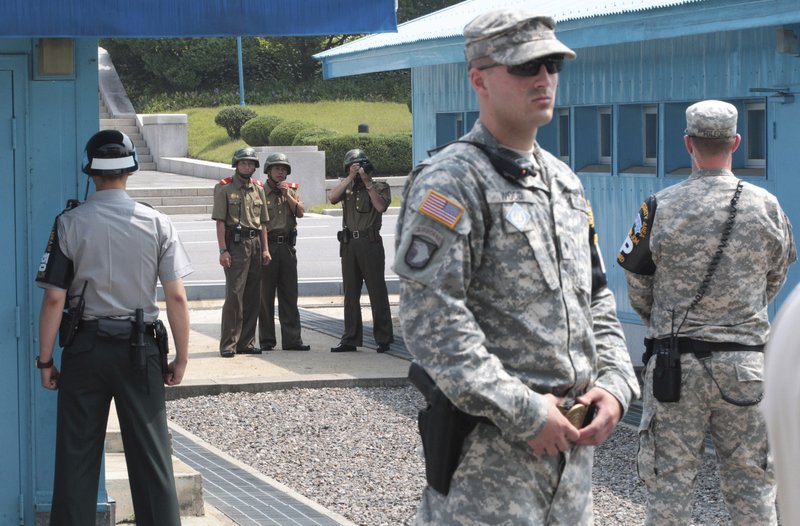SEOUL, South Korea -- North Korea on Saturday threatened to aim fire at the lighting equipment used by "provocative" U.S. and South Korean troops at a truce village inside the demilitarized zone that divides the two Koreas.
The North's Korean People's Army accused U.S. and South Korean soldiers of "deliberate provocations" by aiming their lights at North Korean guard posts at Panmunjom since Friday evening.
The North Koreans said in a statement that the soldiers' actions have seriously threatened the safety of North Korean troops and disrupted their normal monitoring activities.
It said the activities have further angered North Korean soldiers at a time when the Korean Peninsula has reached the "brink of war" because of Monday's start of annual joint military drills between the U.S. and South Korea that Pyongyang says are an invasion rehearsal.
"Floodlight directed at the [North Korean] side at random is taken as an intolerable means of provocation and it will be the target of merciless pinpoint shots," the North Korean army's chief security officers at Panmunjom said in the statement carried by the North's state media.
"The true aim sought by the provocateurs through their recent act is to seriously get on the nerves of the ... soldiers, lead them to take due countermeasures and label them as provocation," it said.
South Korea's Defense Ministry didn't immediately respond to a request for comment.
The statement by North Korea's military came hours after the United Nations Security Council issued a statement strongly condemning four North Korean ballistic missile launches in July and August.
The council expressed "serious concern" late Friday that North Korea carried out the launches after six ballistic missile firings between April and June "in flagrant disregard" of its repeated statements to halt such launches as well as nuclear tests, which violate council resolutions.
South Korean officials said the submarine-launched missile flew about 310 miles, the longest distance achieved by the North for such a weapon.
That means all of South Korea, and possibly parts of Japan, are within its striking distance.
The Security Council statement condemned the Wednesday launch as well as the North's ballistic missile launches on Aug. 2 and July 18 and the firing of a submarine-launched ballistic missile July 9.
In Pyongyang just after the Security Council issued its statement, North Korean Foreign Ministry official Jon Min Dok told Associated Press Television News in an interview that the U.S.-led discussions at the U.N. were a "terrible provocation" and that the country is developing nuclear weapons because of "outrageous nuclear intimidation" by the United States.
He said the latest submarine-launched missile didn't cause any harm to the security of neighboring countries.
He said it showed North Korea's "great power and inexhaustible strength in the face of the trials of history and the challenges of our enemies."
"The best way for the U.S. to escape a deadly strike from us is by refraining from insulting our dignity and threatening our security, by exercising prudence and self-control," Jon said.
North Korea already has a variety of land-based missiles that can hit South Korea and Japan, including U.S. military bases in those countries.
Its development of reliable submarine-launched missiles would add a weapon that is harder to detect before launch.
On Tuesday, the American-led U.N. Command in South Korea accused North Korea of planting land mines near the truce village.
Panmunjom, jointly overseen by North Korea and the U.N. Command, is where an armistice that ended fighting in the 1950-53 Korean War was signed and is now a popular tourist spot for visitors from both sides.
Under the Korean War armistice, the two sides are barred from carrying out any hostile acts within or across the 2.5-mile-wide DMZ. Still, they have accused each other of deploying machine guns and other heavy weapons and combat troops inside the zone.
More than 1 million mines are also believed to be buried inside the zone.
In August 2015, land-mine blasts that Seoul blamed on Pyongyang maimed two South Korean soldiers and caused tensions between the two Koreas to flare.
Information for this article was contributed by Edith M. Lederer of The Associated Press.
A Section on 08/28/2016
